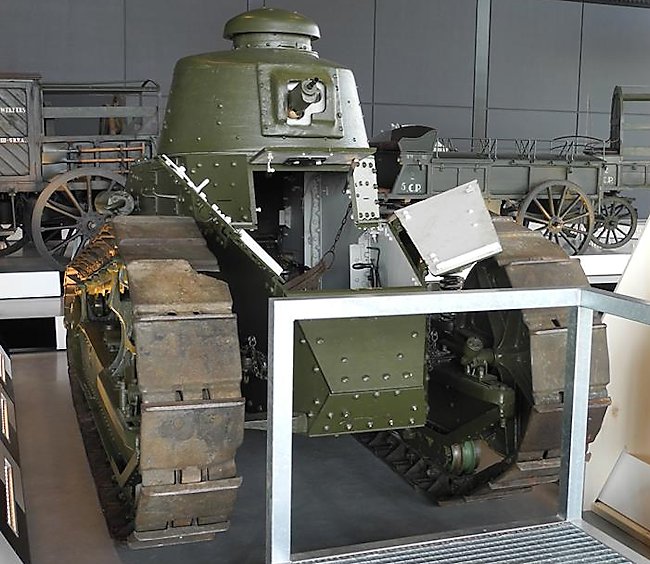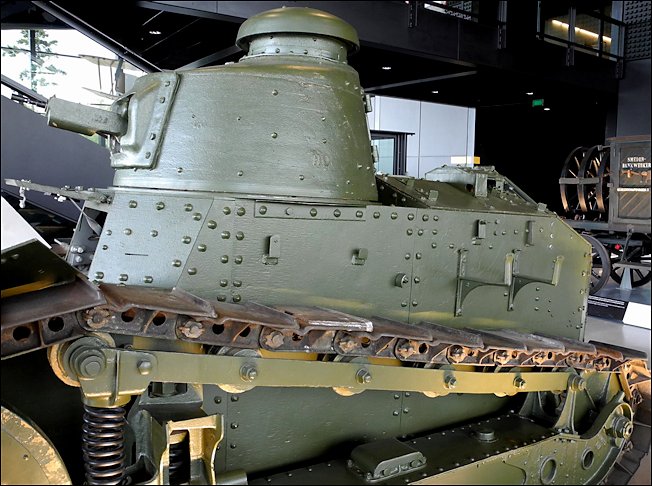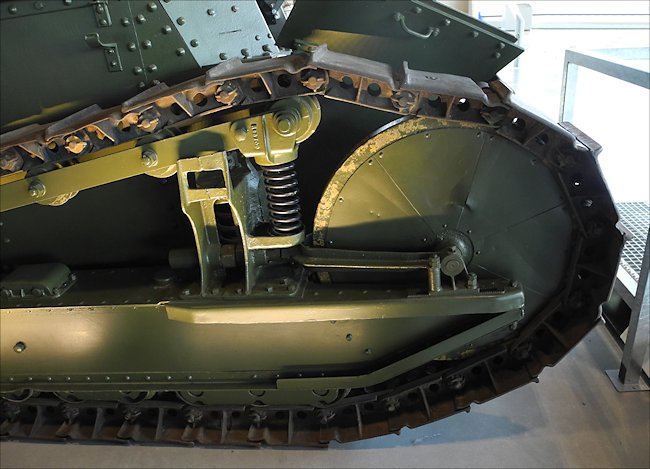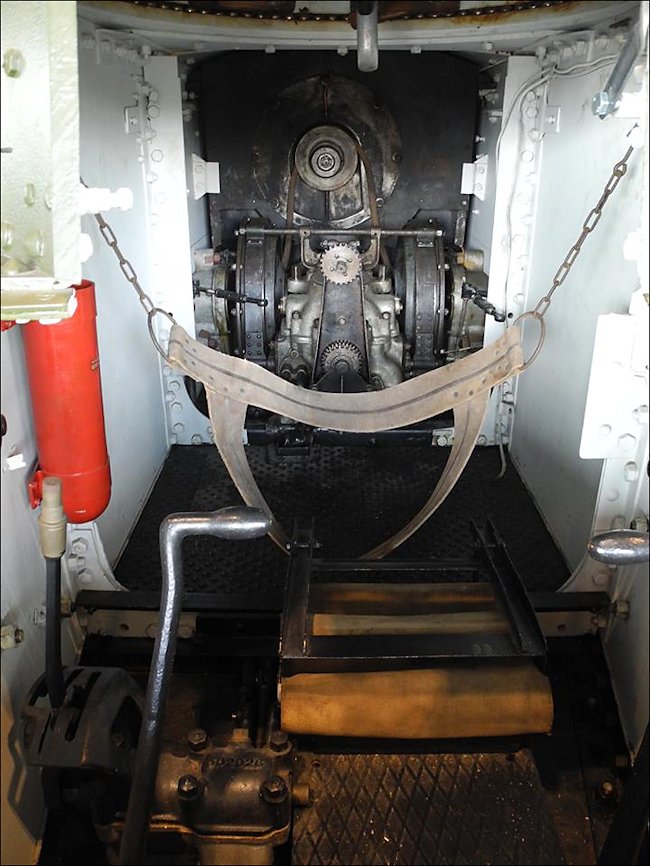Dutch Renault FT
The Dutch Defense Ministry had purchased one French built Renault FT-17 in 1927 to undergo tank trials in the Netherlands. A Renault FT 17 Tank can be seen at the National Military Museum (Nationaal Militair Museum) near Soesterberg in Holland. It was captured by the Germans and used as a Beutepanzer (trophy tank) to guard German airfields in Belgium and Holland. It had a German camouflage pattern but has been restored to look like the Dutch Renault FT tank in 'Army green'.

This Renault FT 17 Tank is at the Nationaal Militair Museum near Soesterberg in Holland. The Dutch Army had a Renault FT tank. (photo: Jan Wim Hasselman)
Location
The Dutch National Military Museum (Nationaal Militair Museum) can be found at Verlengde Paltzerweg 1, 3768 MX Soest, south east of Amsterdam between Utrecht and Amersfoort in the Netherlands. It is closed on Monday. It is open Tuesday - Sunday from 10.00 until 17.00. It is also closed on 25th December, 1st January and 27th April. By train and bus from Amersfoort station, take bus 52 towards Utrecht or bus 56 towards Wijk bij Duurstede. Get off at the "’t Zwaantje" bus stop in Soesterberg. From there, it is approximately a 15-minute walk. From Utrecht Central Station, take bus 52 towards Amersfoort. Get off at the "’t Zwaantje" bus stop in Soesterberg. From there, it is approximately a 15-minute walk.
Specifications
The early Renault FT light tanks were armed with a 8mm Hotchkiss 1914 machine gun in an armoured sleeve. This was later replaced with a 7.5mm Reibel machine gun. Some tanks were armed with a Puteaux SA 1918 37mm canon. It was powered by a Renault 4-cyl, 4.5 litre, thermo-siphon water-cooled gasoline petrol engine. It had a top road speed of 8 km/h (5 mph) and an operational range of only 60 km (37 miles). The two man crew were protected by armour that ranged in thickness from 8mm to 22mm. This would only stop small arms fire and shell shrapnel.

This Renault FT 17 Tank is armed with a 8mm Hotchkiss 1914 machine gun in an armoured sleeve. (photo: Jan Wim Hasselman)
The Dutch Army tank trials
The Dutch Defense Ministry had purchased one French built Renault FT-17 in 1927 to undergo tank trials in the Netherlands. They also had a British Vickers-Armstrong tank. The Renault FT was kept in the Ripperda Kazerne Army barracks in Haarlem. When it started its trials it did not have a machine gun fitted in its turret. So that the tank was exposed to different landscapes, obstacles and problems the tank trials and demonstrations were held at several different military bases around the country.
To test the French tank the local military personnel were tasked with creating battlefield obstacles for the tank to negotiate. some times this just meant that the tank had to cross different types of terrain that existed on that Army base. This could range from small streams, dikes, frozen canals and lakes to woodland.

The Divers position hatches are open on this Renault FT 17 Tank is at the Nationaal Militair Museum near Soesterberg in Holland. (photo: Jan Wim Hasselman)
During WW1 the Dutch had remained neutral and therefore did not have the need to develop an armoured division but its senior officers still took an active interest in what was happening. Only armoured cars were retained for patrol and police duties. When WW2 started the growing Dutch defence budget went mainly to help the Dutch East Indies Company Army and its sizable Navy. The Dutch had a small empire in the far east that produced spices, tea, coffee, fruit, oil and rubber.
Several test were done using new devices to help the Renault FT tank cross ditches. It also underwent trials on ice and flooded fields. The tank was exposed to conditions it could expect to find in Holland during the winter. These trials did not go well. It often got stuck in the bud or sunk in the water.

The tracks on the Renault FT 17 Tank is were relatively wide for the time but they damaged tarmacked and cobbled roads. (photo: Jan Wim Hasselman)
The Dutch Defence committee concluded that the tests were a failure. The tank had proved that it was good at getting over man made obstacles but had failed when trying to negotiate natural obstacles. It had got stuck in ditches in woods. It often could not get out of muddy roads and fields without a tow rope and it had almost sunk in a marsh. It needed a lot of maintenance and often broke down. Its tracks also damaged roads. The defence Committee report said that the tank was too old and slow. It was not powerful enough to get itself out of trouble and that newer tank designs would probably do better.
What was interesting about this report was that its conclusions were used as propaganda by the Dutch Defence Ministry to point out to any hostile neighbour (Germany) that using tanks on Dutch soil would be very problematic. Their tests had shown that the deployment of tanks in the Dutch countryside was difficult as many of the natural obsticals were impassable to tanks.

The drive wheel on the Renault FT 17 light Tank. (photo: Jan Wim Hasselman)
The Dutch army decided to buy Swedish Landswerk armoured cars that could travel at speed on Dutchroads and Dutch armoured cars built by DAF.
The Dutch Renault FT light tank was parked at the Ripperda Military Base and had its engine removed. The 'Waterline Defense' policy, flooding the land to create natural barriers, was what the Dutch defence relied upon. Tanks did not play any part of that tactic.

This is a photo of the sling the Renault FT 17 Tank driver sat in. His steering levers were in front of him. Behind him was the engine. This fact that the engine is still in this tank shows that it is not the original Dutch Army had a Renault FT tank. It had its engine removed. The American version of the Renault FT the M1917 6 ton tank had a bulkhead built between the engine and crew compartment to stop fumes and the heat upsetting the tank crew. (photo: Jan Wim Hasselman)
French tank books

